- Joined
- Apr 2, 2017
- Messages
- 41,042
- Points
- 463
"USS Missouri (BB-63) under attack by Iraqi Silkworm". Painting, oil on canvas board by John Charles Roach, 1991.

While providing gunfire support to harass the Iraqi troops in Kuwait in preparation for a possible amphibious landing, USS Missouri (BB-63) was fired upon by an Iraqi silkworm anti-ship missile. By the use of infrared flares and chaff, the missile's guidance was confused. It crossed close astern of Missouri and was engaged and shot down by HMS Gloucester (D-96).

While providing gunfire support to harass the Iraqi troops in Kuwait in preparation for a possible amphibious landing, USS Missouri (BB-63) was fired upon by an Iraqi silkworm anti-ship missile. By the use of infrared flares and chaff, the missile's guidance was confused. It crossed close astern of Missouri and was engaged and shot down by HMS Gloucester (D-96).












